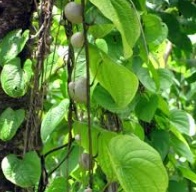Varvain Glucoside from the Stem Bark of <i>Ceiba Pentandra</i> Controls Postharvest Loss in<i>Dioscorea alata</i> Tubers
Main Article Content
Abstract
Ceiba pentandra is a plant renowned for its wound healing ability and antimicrobial characteristics. This work focused on isolating and characterizing antimicrobial compounds from the stem bark of Ceiba pentandra. Plant extracts were prepared by successive maceration of the ground stem bark in hexane, ethyl acetate, and methanol. The extracts were subjected to column chromatography on silica gel to isolate compounds that could be used as antimicrobial agents against tuber rot in Dioscorea alata. The compounds obtained were varvain-3-O-glucoside, ferulic acid, catechin-3-O-glucoside, and a mixture of sitosterol and stigmasterol. The compounds were identified using NMR and high-resolution mass spectrometry techniques, and their identities were verified by comparing their data with information found in literature reports. Antimicrobial assays of the extracts and isolated compounds against bacterial and fungal isolates from Dioscorea alata tubers revealed that the compounds are active against tuber rot bacteria and fungi with MICs between 50.0 and 12.5 µg/mL. The extracts were less active, with MICs between 50.0 and 25.0 µg/mL. In conclusion, the relatively low MICs indicate the ability of these compounds to inhibit the growth of pathogenic microorganisms commonly associated with postharvest losses of Dioscorea alata tubers.
Metrics
Article Details

This work is licensed under a Creative Commons Attribution-NonCommercial 4.0 International License.
References
Anand U, Jacobo-Herrera N, Altemimi A, Lakhssassi N. A comprehensive review on medicinal plants as antimicrobial therapeutics: potential avenues of biocompatible drug discovery. Metabolites. 2019; 9(11): 258.
Obakiro SB, Kiprop A, Kowino I, Kigondu E, Odero MP, Omara T, Bunalema L. Ethnobotany, ethnopharmacology, and phytochemistry of traditional medicinal plants used in the management of symptoms of tuberculosis in East Africa: a systematic review. Trop Med and Health. 2020; 48: 1-21.
Friday A, Otalu O, Ukwubile CA, Onoruoyiza OV, Edisha GD. Use of Medicinal Plants as Antimicrobial Agents: A Review of the Successes Story. Inter J of Med Plants and Nat Prod. 2020; 6(3): 28-33.
Gómez-Maqueo X, Gamboa-deBuen A. The biology of the genus Ceiba, a potential source for sustainable production of natural fibre. Plants. 2022; 11(4): 521.
Baraniak J, Kania-Dobrowolska M. Multipurpose utilization of kapok fibre and properties of ceiba pentandra tree in various branches of industry. J of Nat Fibres. 2023; 20(1): 2192542.
Ayorinde JO, Okonye EO. Antioxidant properties and effects of formulation variables on Ceiba pentandra microspheres. Nig J of Pharm Research. 2023; 19(1): 1-6.
Gbolade A, Ojeh-Oziegbe O, Uazama P. Growth inhibitory and cytotoxic study of Ceiba pentandra (L.) Gaertn. Leaf (Malvaceae) and Cascabela thevetia (L.) Lippold root bark (Apocynaceae). J of Pharm and Phytochem 2019; 8(5): 1712-7.
Banso A, Ajayi MA. Phytochemical and antimicrobial activity of Ceiba pentandra against some pathogenic bacteria. J of Current Opinion in Crop Sci. 2023; 4(4): 179-84.
Altemimi A, Lakhssassi N, Baharlouei A, Watson DG, Lightfoot DA. Phytochemicals: Extraction, isolation, and identification of bioactive compounds from plant extracts. Plants. 2017; 6(4): 42.
Raina AP, Misra RC. Evaluation of diosgenin, a bioactive compound from natural source of Dioscorea species: A wild edible tuber plant. J of Pharma and Phytochem. 2020; 9(1): 1120-4.
Nan SH, Wang PT, Zhu QL, Sun JY, Zhang HY, Liu XY, Cao TX, Xin CH, Huang YJ, Zhou QH. Comprehensive characterization of yam tuber nutrition and medicinal quality of Dioscorea opposita and D. alata from different geographic groups in China. J of Integra. Agri. 2020; 19(11): 2839-48.
Azeteh IN, Hanna R, Sakwe PN, Njukeng AP, Kumar PL. Yam (Dioscorea spp.) production trends in Cameroon: A review. Afr. J. Agric. Res. 2019; 14(26): 1097-110.
Frank CO, Kingsley CA. Proximate composition, physiological changes during storage, and shelf life of some Nigerian varieties of yams (Dioscorea species). J of Sci Research and Reports. 2014; 3(4): 553-62.
Ogunleye AO, Ayansola OT. Studies of some isolated rot-causing mycoflora of yams. Am. J. Microbiol. Biotechnol. 2014; 1(1): 9-20.
Elion Itou RD, Sanogo R, Etou Ossibi AW, Nsondé Ntandou FG, Ondelé R, Max Pénemé B, Okiémy Andissa N, Diallo D, Ouamba JM, Abena AA. Anti-inflammatory and analgesic effects of aqueous extract of stem bark of Ceiba pentandra Gaertn. Pharmacology & Pharmacy. 2014; 5(12): 1113-8.
Adeniji A. The methods of controlling yam tuber rot in storage: a review. Int. J. Innov. Biol. Chem. Sci. 2019; 12: 11-7.
Tagousop CN, Tamokou JD, Kengne IC, Ngnokam D, Voutquenne-Nazabadioko L. Antimicrobial activities of saponins from Melanthera elliptica and their synergistic effects with antibiotics against pathogenic phenotypes. Chem Central J. 2018; 12: 1-9.
Ueda H, Kaneda N, Kawanishi K, Alves SM, Moriyasu M. A New Isoflavone Glycoside from Ceiba pentandra (L.) G Aertner. Chem and pharm bulletin. 2002; 50(3): 403-4.
Sajjadi SE, Shokoohinia Y, Moayedi NS. Isolation and Identification of Ferulic Acid from Aerial Parts of Kelussia odoratissima Mozaff. Jundishapur J of Nat Pharm Pro. 2012; 7(4): 159.
Pierre LL, Moses MN. Isolation and characterization of stigmasterol and β-sitosterol from Odontonema strictum (acanthaceae). J of Innovation in Pharm and Bio Sci. 2015; 2(1): 88-95.
Shirai A, Kunimi H, Tsuchiya K. Antifungal action of the combination of ferulic acid and ultraviolet‐A irradiation against Saccharomyces cerevisiae. J of Applied Microbio. 2022; 132(4): 2957-67.


